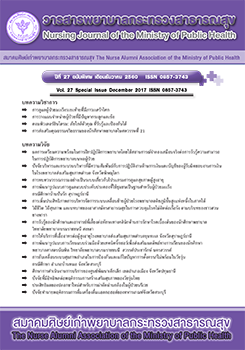Predictive Factors of Alcohol Drinking Behaviors of Draftees in Saraburi Province
Main Article Content
Abstract
This research study explored alcohol drinking behaviors, adverse effects on health, and factors predicting drinking behaviors. Participants were 256 draftees from military units in Saraburi province. Data were collected in May 2017 using personal information, adverse effects on health, and social and environment questionnaires. The data were analyzed using descriptive statistics and regression analysis. It showed 64.45% of draftees had temporarily stopped drinking and 27.73% were current drinkers. Drinking frequency in the past month were 32.81% for 1-2 days and 13.67% for 3-5 days. The identification of risk for alcohol dependence was 55.5%, the harmful drinker was 25.8%, and the hazardous drinker was 14.1%. The exposure to alcohol advertisement was at a moderate level. Predictive factors of current drinking were age, exposure to alcohol in the media, and intention to stop drinking. The predictive factors of drinking in the past month were age, education, family drinkers, knowledge about alcohol consequences, alcohol in the media, and intention to stop drinking. The predictive factors of drinking in the past year were age, education, family drinkers, knowledge about alcohol consequences, alcohol in the media, and intention to stop drinking. This study indicates the importance of health promotion and prevention, especially for the draftees that reported to
continue with their drinking, on alcohol dependence.
Article Details
บทความและรายงานวิจัยในวารสารพยาบาลกระทรวงสาธารณสุข เป็นความคิดเห็นของ ผู้เขียน มิใช่ของคณะผู้จัดทำ และมิใช่ความรับผิดชอบของสมาคมศิษย์เก่าพยาบาลกระทรวงสาธารณสุข ซึ่งสามารถนำไปอ้างอิงได้
References
2. Assanangkornchai S, Sam-Angsri N, Rerngpongpan S, Lertnakorn A. Patterns of alcohol consumption in the Thai population: results of the National Household Survey of 2007. Alcohol Alcohol. 2010;45(3):278-85
3. National Statistic Office. National survey on cigarettes and alcohol usage of population; 2014. [cited 2017 Aug 15] Available from: http://service.nso.go.th/nso/nsopublish/themes/files/smokePocket57.pdf
4. Kaewjundra N, Rungreungkolakij S, Arunphongpaisarn S. Predictors of binge drinking behaviors among vocational education students at a private institution. J Psychiatr Assoc Thailand. 2011; 56(4):377-94.
5. Thepnu J. Factors effects drinking alcohol of high school students in Pattalung province [Thesis]. Bangkok: Mahidol University; 2010.
6. Navamarat T. Anti-alcohol advertising influence behavior of Bangkok metropolitan population in reducing quantity of drinking alcoholic beverage [Master’s Project]. Bangkok: rinakharinwirot University;2008.
7. Tasuwan S. The study of factors influencing to the behavior of the impact of the violation of the fifth precept: a case study of the transportation regiment of king guard. [Thesis]. Bangkok: Mahachulalongkomrajavidyalaya University; 2011.
8. Sukmee T. New generation soldiers attend on drinking. Phramongkutklao College of Medicine; 2006. [cited 2017 Aug 13]. Available from: file:///C:/Users/user/Downloads/1_143%20 (1).pdf
9. MacQueen KM, Nopkesorn T, Sweat MD, Sawaengdee Y, Mastro TD, Weniger BG. Alcohol consumption, brothel attendance, and condom use: normative expectations among Thai military conscripts. Med Anthropol Q. 1996;10(3):402-23.
10. Williams JO, Bell NS, Amoroso PJ. Drinking and other risk taking behaviors of enlisted male soldiers in the US army. Work. 2002;18(2):141-50.
11. Cohen J. Quantitative methods in psychology: a power primer. Psychol Bull. 92;112(1):155-59.
12. Babor TF, Higgins-Biddle JC, Saunders JB, Monteiro MG. AUDIT: the alcohol use disorders identification test: guidelines for use in primary health care. 2nd ed. Geneva: WHO; 2011.
13. Aekbunasingha P, Kengkarnpanich T, Kengkarnpanich M, Sinnhung A. Health promoting behavior among the Royal Thai army under quality of life development project. J Health Ed. 2007; 30(105):75-105.
14. Hanwella R, de Silva VA, Jayasekera NE. Alcohol use in a military population deployed in combat areas: a cross sectional study. Sub Abuse Treat Prev Pol. 2012;7(24):1-7.
15. Lande RG, Marlin BA, Chang AS, Lande GR. Gender differences and alcohol use in the US army. J Ame Ost Asso. 2007;107(9):401-7.
16. Stahre MA, Brewer R, Fonseca VP, Naimi TS. Binge drinking among U.S. active-duty military personnel. Am J Prev Med. 2009;36 (3):208-17.
17. Petchsuk R. A causal model of alcohol consumption behavior amongst high school students receiving school health service. [Dissertation]. Bangkok: Christian University; 2010.
18. Buasorn R, & Ratchadapunnathikul C. Alcohol consumption behavior of bachelor degree students in the Bangkok area. Rama Nurs J. 2012; 18(2):259-71.
19. Standard drink – Know your limit [cited 2017 Oct 28]. Available from: https://thesaney. wordpress.com/2011/01/19/ดื่มมาตราฐาน-standard-drink-know-your-limit/

